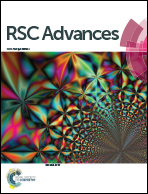Selective naked-eye cyanide detection in aqueous media using a carbazole-derived fluorescent dye†
Abstract
A Michael addition activated chemodosimeter was designed with a carbazole donor and a dicyanovinyl acceptor. The design features an acceptor–donor–acceptor (A–D–A) molecular configuration and the cyanide addition on the electron-deficient alkene bridge breaks the donor–acceptor interaction and produces a blue shift in the absorption and emission profiles. The ratiometric and colorimetric changes of the probes were monitored by the changes in absorption and fluorescence spectra. The probes exhibited excellent selectivity towards CN− over other anions such as F−, OAc−, NO3−, NO2−, S2O3−, H2PO4−, SCN−, I−, Br−, and SO4−. The action of the chemodosimeter was investigated by 1H-NMR titrations and DFT/TDDFT theoretical calculations which supported the formation of dicyanide addition adducts (CN–probes–CN)−2 with the probes. Paper strips developed using the dyes displayed excellent response for the detection of CN− in aqueous solutions. The detection limits of the probes 3a (0.126 μM) and 3b (0.140 μM) for cyanide are lower than the maximum permissible level of CN− (1.9 μM) in drinking water.


 Please wait while we load your content...
Please wait while we load your content...